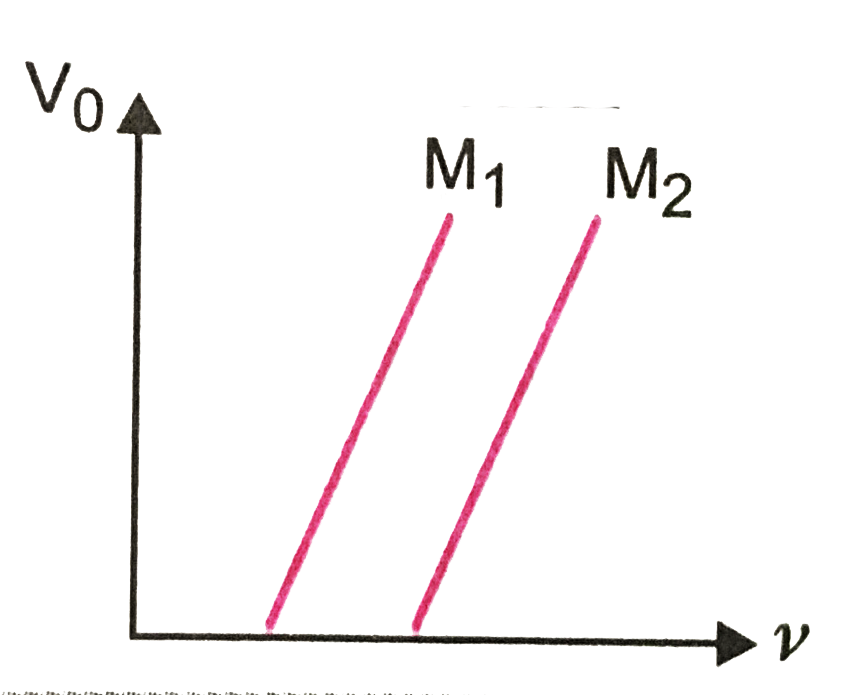Ultraviolet radiation of different frequencies v1andv2 are incident on two photosensitive materials having work functions ϕ1andϕ2(ϕ1>ϕ2) respectively. The kinetic energy of the emitted electrons is same in both the cases. which one of the two radiations will be of higher frequency ?
As per relation hv=ϕ+(K.E.)max we find that v1>v2.
Topper's Solved these Questions
- BOOK - U-LIKE SERIESCHAPTER - DUAL NATURE OF RADIATION AND MATTEREXERCISE - SHORT ANSWER QUESTIONS27videos
DUAL NATURE OF RADIATION AND MATTER
- BOOK - U-LIKE SERIESCHAPTER - DUAL NATURE OF RADIATION AND MATTEREXERCISE - LONG ANSWER QUESTIONS19videos
DUAL NATURE OF RADIATION AND MATTER
- BOOK - U-LIKE SERIESCHAPTER - DUAL NATURE OF RADIATION AND MATTEREXERCISE - ASSERTION REASON TYPE QUESTIONS5videos
DUAL NATURE OF RADIATION AND MATTER
- BOOK - U-LIKE SERIESCHAPTER - CURRENT ELECTRICITY EXERCISE - SELF ASSESSMENT TEST (SECTION C )3videos
CURRENT ELECTRICITY
- BOOK - U-LIKE SERIESCHAPTER - ELECTRIC CHARGES AND FIELDS EXERCISE - SELF ASSESSMENT TEST (SECTION-B) (VERY SHORT ANSWER QUESTIONS)4videos
ELECTRIC CHARGES AND FIELDS
Similar Questions
Ultraviolet radiations of different frequencies v1are incident on two photosensitive materials having work functions W1 and W2(W1>W2) respectively. The kinetic energy of the emitted electrons is same in both the cases. Which one of the two radiations will be of higher frequency?
View SolutionUltraviolet light is incident on two photosensitive materials having work function W1 and W2(W1>W2). In which case will the kintic enrgy of the emitted electrons be greater? Why?
View Solution
Knowledge Check
- Question 1 - Select One
Photoelectric emission is observed from a metallic surface for frequencies v1andv2 of the incident light. If the maximum value of kinetic energies of the photoelectrons emitted in the two cases are in the ratio n:1 then the threshold frequency of the metallic surface is
Av1=v2Bv1−v2hC2v1−v2D2v2−v1 - Question 2 - Select One or More
A beam of ligth having frequency v is incident on an initially neutral metal or work function ϕ(hv>ϕ). Then
Aall emitted photoelectrons have kinetic energy equal to (hv>ϕ)Ball free electrons in the metal, that absorb photons of energy hv completely, may not be ejected out of the metal.Cafter being emitted out of the metal, the kinetic energy of photoelectrons decreases continuously as long as they are at a finite distance from metal .Dthe emitted photo electrons move with constant speed after escaping from the electric field of metal. - Question 3 - Select One
Photoelectric emission is observed from a surface for frequencies v1andv2 of the incident radiation (v1>v2) . If maximum kinetic energies of the photo electrons in the two cases are in the ratio 1:K , then the threshold frequency is given by:
Av2−v1K−1BKv2−v1K−1CKv2−v1KDKv1−v2K−1
Ultraviolet light is incident on two photosensitive materials having work function W1 and W2(W1>W2). In which case will the kintic enrgy of the emitted electrons be greater? Why?
View SolutionUltraviolet light is incident on two photosenstive materials having work functions ϕ1 and ϕ2(ϕ1>ϕ2). In which case will the K.E. of the emitted electrons be greater ? Why ?
View SolutionPhotoelectric emission is observed from a metal surface for frequencies v1 and v2 incidents radiations (v1>v2). If the maximum kinetic energy of the two electrons are in the ratio 1:2, then how is threshold frequency (v∘) experssed.
View Solutionfig. shows variation of stopping potential (V0) with frequency (v) for two photosenstive matrials M1andM2.

(i) why is the slope same for both lines?
(ii) For which material will the emitted electrons have greater kinetic energy for the incident radiations of the same frequency? Justify your answer.View SolutionPhotoelectric emission is observed from a surface for frequencies v1andv2 of the incident radiation (v1>v2) . If maximum kinetic energies of the photo electrons in the two cases are in the ratio 1:K , then the threshold frequency is given by:
View Solution

